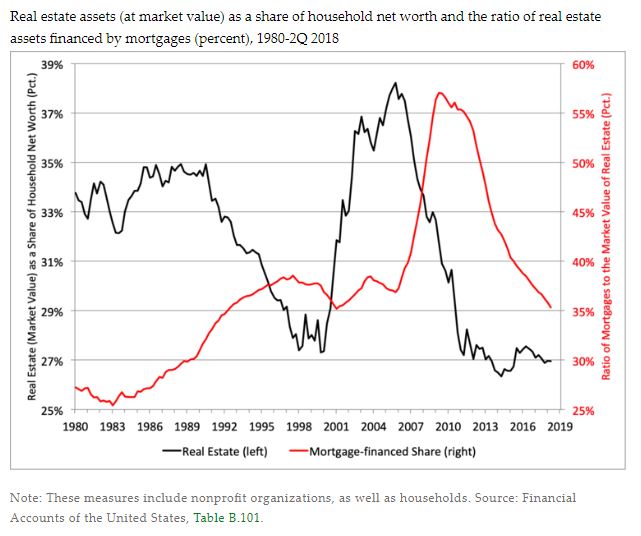Friday, October 19, 2018
More evidence that it’s really hard to ‘beat the market’
According to Mark Perry of Carpe Diem: “over the last 15 years from June 30, 2003 to June 30, 2018, only one in 13 large-cap managers, only one in 21 mid-cap managers, and one in 43 small-cap managers were able to outperform their benchmark index. So it is possible for some active fund managers to “beat the market” over various time horizons, although there’s no guarantee that they will continue to do so in the future. And the percentage of active managers who do beat the market is usually pretty small – fewer than 8% in most of the cases above over the last 15 years; and they may not sustain that performance in the future.”
Read the full story here, which gives a link to the underlying study.
According to Mark Perry of Carpe Diem: “over the last 15 years from June 30, 2003 to June 30, 2018, only one in 13 large-cap managers, only one in 21 mid-cap managers, and one in 43 small-cap managers were able to outperform their benchmark index. So it is possible for some active fund managers to “beat the market” over various time horizons, although there’s no guarantee that they will continue to do so in the future.
Posted by at 10:36 AM
Labels: Macro Demystified
Housing View – October 19, 2018
On cross-country:
- Homeownership motivation, rationality, and housing prices: Evidence from gloom, boom, and bust‐and‐boom economies – International Journal of Finance & Economics
On the US:
- Assessing Housing Risk – Money and Banking
- Local regulatory responses during a regional housing shortage: An analysis of rezonings in Silicon Valley – Land Use Policy
- HUD can’t fix exclusionary zoning by withholding CDBG funds – Brookings
- Housing Market Is Raising Serious Red Flags – Bloomberg
- Promoting Luxury Housing with an Ironic Twist – Institute for Policy Studies
- Homebuilding Isn’t What It Used to Be – Bloomberg
- Reconciling the back to the city thesis with sustained suburban growth – Harvard Joint Center for Housing Studies
- Airbnb and Neighborhood Conflict – Cato Institute
- Slower Growth Anticipated in Home Remodeling – Harvard Joint Center for Housing Studies
On other countries:
- [Austria] Austrian Housing Policy – Dublin Economics
- [Canada] Condo Flippers Aren’t the Vancouver and Toronto Housing Culprits – Bloomberg
- [China] China homeowners stage protests over falling prices – Financial Times
- [United Kingdom] No, the housing crisis will not be solved by building more homes – Financial Times
Photo by Aliis Sinisalu
On cross-country:
- Homeownership motivation, rationality, and housing prices: Evidence from gloom, boom, and bust‐and‐boom economies – International Journal of Finance & Economics
On the US:
- Assessing Housing Risk – Money and Banking
- Local regulatory responses during a regional housing shortage: An analysis of rezonings in Silicon Valley – Land Use Policy
- HUD can’t fix exclusionary zoning by withholding CDBG funds – Brookings
- Housing Market Is Raising Serious Red Flags – Bloomberg
- Promoting Luxury Housing with an Ironic Twist – Institute for Policy Studies
- Homebuilding Isn’t What It Used to Be – Bloomberg
- Reconciling the back to the city thesis with sustained suburban growth – Harvard Joint Center for Housing Studies
- Airbnb and Neighborhood Conflict – Cato Institute
- Slower Growth Anticipated in Home Remodeling – Harvard Joint Center for Housing Studies
Posted by at 5:00 AM
Labels: Global Housing Watch
Thursday, October 18, 2018
Highlights of the Economic Outlook for the Euro Area
From the Economic Outlook for the Euro Area in 2018 and 2019:
“Signs of a slowing world economy are piling up: Since the beginning of the year purchasing manager indices have been declining globally, in summer higher US interest rates led investors to withdraw capital from emerging markets, and as a consequence, capital costs rose and currencies depreciated in many emerging markets economies. In October stock prices decreased markedly worldwide including the US, despite the strong upswing in this country.
As a consequence of the turmoil on financial markets, monetary conditions in many emerging economies are no longer favorable. What ultimately counts for the prospects of the global economy, is, however, the performance of the US, the Euro area, China and Japan. The upswing in the US appears stable enough to continue well into 2019. While at present the rest of the group appears to lose momentum, there is a good chance that production in each of these economies will still expand at rates that are close to their potential growth. Further protectionist rounds are the most important risk to this scenario.”
“In the first half of the current year the euro area economy expanded at a markedly slower rate than in 2017, about 0.4% per quarter, but still substantial. Rising risk premia on Italian assets will probably force banks in this large country to tighten credit conditions, and a slowing world trade will dent export growth. All in all, we expect GDP growth in the euro area to go down from 2.4% in 2017 to 2.0% in 2018 and to 1.7% in 2019.”
“Employment continues to expand and vacancy rates are at present higher than in 2017. As a consequence, wages rise more quickly: nominal compensations per employee started accelerating early in 2017, and negotiated wages followed at the beginning of 2018. Wage inflation of slightly below 2.5% and healthy growth in employment raise real labor incomes markedly.
Our forecasts are based on the assumption that rating agencies will continue as-signing investment grade to the Italian government debt, and that the Italian government and the European Commission will find a compromise about the draft budget of the country in the coming weeks. Another assumption is that the UK will not exit the EU in an unorderly way in March 2019”
From the Economic Outlook for the Euro Area in 2018 and 2019:
“Signs of a slowing world economy are piling up: Since the beginning of the year purchasing manager indices have been declining globally, in summer higher US interest rates led investors to withdraw capital from emerging markets, and as a consequence, capital costs rose and currencies depreciated in many emerging markets economies. In October stock prices decreased markedly worldwide including the US,
Posted by at 5:32 PM
Labels: Forecasting Forum
Assessing Housing Risk
From Money and Banking:
“Housing debt typically is on the short list of key sources of risk in modern financial systems and economies. The reasons are simple: there is plenty of it; it often sits on the balance sheets of leveraged intermediaries, creating a large common exposure; as collateralized debt, its value is sensitive to the fluctuations of housing prices (which are volatile and correlated with the business cycle), resulting in a large undiversifiable risk; and, changes in housing leverage (based on market value) influence the economy through their impact on both household spending and the financial system (see, for example, Mian and Sufi).
In this post, we discuss ways to assess housing risk—that is, the risk that house price declines could result (as they did in the financial crisis) in negative equity for many homeowners. Absent an income shock—say, from illness or job loss—negative equity need not lead to delinquency (let alone default), but it sharply raises that likelihood at the same time that it can depress spending. As it turns out, housing leverage by itself is not a terribly useful leading indicator: it can appear low merely because housing prices are unsustainably high, or high because housing prices are temporarily low. That alone provides a powerful argument for regular stress-testing of housing leverage. And, because housing markets tend to be highly localized—with substantial geographic differences in both the level and the volatility of prices—it is essential that testing be at the local level.”
Continue reading here.
From Money and Banking:
“Housing debt typically is on the short list of key sources of risk in modern financial systems and economies. The reasons are simple: there is plenty of it; it often sits on the balance sheets of leveraged intermediaries, creating a large common exposure; as collateralized debt, its value is sensitive to the fluctuations of housing prices (which are volatile and correlated with the business cycle),
Posted by at 8:19 AM
Labels: Global Housing Watch
Common factors of commodity prices
From ECB’s Research Bulletin:
“Looking at the co-movement in a broad group of commodity prices is key to identifying the nature of commodity price fluctuations. In conclusion, this Research Bulletin article highlights a very simple strategy that central bankers can use to understand the drivers behind commodity price fluctuations. If commodity prices in all markets tend to move in the same direction and by a similar magnitude, then the global demand for commodities is largely responsible for those movements. If commodity price variations are instead localised to a few markets and/or there are important changes in relative prices, then other specific factors related to supply and demand in individual markets are likely to be at play.”
From ECB’s Research Bulletin:
“Looking at the co-movement in a broad group of commodity prices is key to identifying the nature of commodity price fluctuations. In conclusion, this Research Bulletin article highlights a very simple strategy that central bankers can use to understand the drivers behind commodity price fluctuations. If commodity prices in all markets tend to move in the same direction and by a similar magnitude, then the global demand for commodities is largely responsible for those movements.
Posted by at 8:14 AM
Labels: Energy & Climate Change
Subscribe to: Posts








